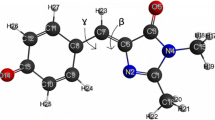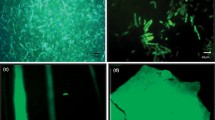Abstract
Green fluorescent protein (GFP) is frequently utilized for metal ion detection and quantification. To improve the metal binding potential of GFP, three residues (N146, F165, and L201) were substituted to histidines. Each variant responded differently upon interaction with metal ions. More than 80% of N146H, having the most accessible surface area, could bind to immobilized metal ions. However, only F165H exhibited significant differences in quenching by soluble metal ions (22% fluorescence decrease) in comparison with the template protein (12%). These findings can be utilized for designing GFP variants for metal binding and sensor applications.






Similar content being viewed by others
References
Ahmed S, Gromiha M, Fawareh H et al (2004) ASAview: Database and tool for solvent accessibility representation. BMC Bioinformatics 5:51–55
Chen WY, Wu CF, Liu CC (1996) Interactions of imidazole and proteins with immobilized Cu(II) ions: Effects of structure, salt concentration, and pH in affinity and binding capacity. J Colloid Interface Sci 180:135–143
Crameri A, Whitehorn EA, Tate E et al (1996) Improved green fluorescent protein by molecular evolution using DNA shuffling. Nat Biotechnol 14:315–19
Eli MA, Chakrabartty A (2006) Variants of DsRed fluorescent protein: Development of a copper sensor. Protein Sci 15:2442–2447
Helms V, Straatsma TP, McCammon JA (1999) Internal dynamics of green fluorescent protein. J Phys Chem 103:3263–3269
Jensen KK, Martini L, Schwartz TW (2001) Enhanced fluorescence response energy transfer between spectral variants of green fluorescent protein through zinc-site engineering. Biochemistry 40:938–945
Mejare M, Bulow L (2001) Metal-binding proteins and peptides in bioremediation and phytoremediation of heavy metals. Trends Biotechnol 19:67–73
Ormö M, Cubitt AB, Kallio K et al (1996) Crystal structure of the Aequorea victoria green fluorescent protein. Science 273:1392–1395
Pédelacq JD, Cabantous S, Tran T et al (2005) Engineering and characterization of a superfolder green fluorescent protein. Nat Biotechnol 24:79–88
Prachayasittikul V, Isarankura-Na-Ayudhya C, Galla HJ (2004) Binding of chimeric metal-binding green fluorescent protein to lipid monolayer. Eur Biophys J 33:522–534
Prachayasittikul V, Isarankura-Na-Ayudhya C, Tantimongcolwat T et al (2005a) Nanoscale orientation and lateral organization of chimeric metal-binding green fluorescent protein on lipid membrane determined by epifluorescence and atomic force microscopy. Biochem Biophys Res Commun 326:298–306
Prachayasittikul V, Isarankura-Na-Ayudhya C, Hilterhaus L et al (2005b) Interaction analysis of chimeric metal-binding green fluorescent protein and artificial solid-supported lipid membrane by quartz crystal microbalance and atomic force microscopy. Biochem Biophys Res Commun 327:174–182
Richmond TA, Takahashi TT, Shimkhada R et al (2000) Engineered metal binding sites on green fluorescence protein. Biochem. Biophys Res Commun 268:462–465
Seifert MHJ, Georgescu J, Ksiazek D et al (2003) Backbone dynamics of green fluorescent protein and the effect of histidine 148 substitution. Biochemistry 42:2500–2512
Sumner JP, Westerberg NM, Stoddard AK et al (2006) DsRed as a highly sensitive, selective, and reversible fluorescence-based biosensor for both Cu1+ and Cu2+ ions. Biosen Bioelec 21:1302–1308
Acknowledgements
NT is grateful for the Royal Golden Jubilee (RGJ) Ph.D. scholarship under V.P. supervision from the Thailand Research Fund (TRF). This project was also supported by the National Science Research Foundation (VR) and an annual budget grant of Mahidol University (Project No. 02012053-0003).
Author information
Authors and Affiliations
Corresponding author
Electronic supplementary material
Below is the link to the electronic supplementary material.
Rights and permissions
About this article
Cite this article
Tansila, N., Becker, K., Na-Ayudhya, C.I. et al. Metal ion accessibility of histidine-modified superfolder green fluorescent protein expressed in Escherichia coli . Biotechnol Lett 30, 1391–1396 (2008). https://doi.org/10.1007/s10529-008-9692-7
Received:
Revised:
Accepted:
Published:
Issue Date:
DOI: https://doi.org/10.1007/s10529-008-9692-7




